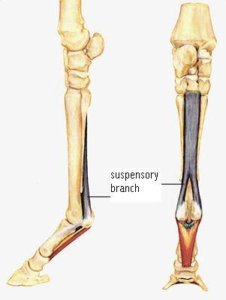Part 2: Treating a Suspensory Branch Lesion with Platelet Rich Plasma
by Jennifer Finley, DVM, Ph.D.
As discussed in part one of this case study (March 2013 issue), platelet rich plasma, or PRP, therapy was recommended for the Thoroughbred gelding racehorse with a lateral suspensory branch tear. Though PRP can be used at any time during the rehab of a tendon or ligament injury, we recommend two to four weeks after occurrence. This horse was injected 15 days post-injury.
Upon arrival at the hospital, he was prepped for the first step in the process: the blood draw. PRP is derived from blood that is drawn directly from the patient. Because the patient’s own blood is used to make the specialized plasma, there is no risk of the treatment being rejected. Once the whole blood was drawn aseptically from the jugular vein of the gelding into a syringe containing anti-coagulant, it was processed using the Magellan centrifuge. The centrifuge extracts the blood from the collection syringe. Following a series of spins, it automatically detects the PRP interface, which is extracted and loaded into a secondary collection syringe. The plasma collected has a platelet concentration level that is five times richer than regular blood. Between 3 and 10 milliliters (mls) of PRP can be collected from 60 mls of whole blood.

While the PRP was being processed, the injection site was prepared. The area over the lesion was clipped and scrubbed, and the fetlock region was blocked with carbocaine. The gelding was then given a small amount of sedation, as it is very important for the horse to remain still for the procedure. With the PRP sample ready, the lesion was again located using ultrasound. The needle was appropriately placed within the lesion under ultrasound guidance. Accuracy at this step is important, as the goal of intra-lesional PRP therapy is to minimize damage to surrounding tissue through precise placement of the PRP within the lesion. The desired injection volume is about 1 ml of PRP per 3 percent lesion size. The goal in most acute lesions is to fill the defect without separating fibers and creating additional damage. Most tendon and ligament injuries will easily take between 3 and 6 mls of PRP. For this case, 4 mls was chosen based on the size (12 percent) and location of this particular lesion in the suspensory branch.
The platelets become activated in their new environment following injection and release their granular contents. The platelet α-granules are abundant and contain many of the growth factors responsible for the initiation and maintenance of all phases of healing. The active secretion of these proteins by platelets begins within 10 minutes, with more than 95 percent of the pre-synthesized growth factors secreted within 1 hour. After this initial burst, the platelets synthesize and secrete additional proteins for the balance of their life (five to 10 days). Furthermore, the fibrin matrix formed following platelet activation provides a physical scaffolding for wound fibroblast migration and ultimate healing.
Following injection, the leg was bandaged and the gelding was ready to leave the hospital and begin rehab. At the rehab center, the limb remained bandaged for the first four weeks and was also treated daily with Game Ready (active compression and dry cold therapy) to reduce swelling and encourage circulation. The gelding had hyperbaric oxygen chamber therapy each day for the first five days, followed by every other day for five more treatments. Three days post-injection, he began hand walking for 15 minutes once per day. This was gradually increased to 30 minutes over two months. At two months post-injection, controlled exercise was allowed on the HydroHorse underwater treadmill in combination with hand walking. At three months, swimming was added to increase fitness without applying concussive forces to the healing ligament. He began jogging for five minutes without a rider at five months post-injection, and over the following three months, the time was gradually increased and a rider was added. At eight months, the gelding returned to the racetrack.
Re-examination with ultrasound was conducted every 30 days over the first two months, then every 60 to 90 days during the remaining healing period. As of this writing, the gelding is prepared to enter his first race since the original injury. He is training well and has remained consistently sound. In most cases, only a single intra-lesional injection of PRP followed by a program of gradually increased exercise will provide an excellent prognosis for returning to racing.
Published April 2013 Issue

The Northwest Horse Source is an independently owned and operated print and online magazine for horse owners and enthusiasts of all breeds and disciplines in the Pacific Northwest. Our contemporary editorial columns are predominantly written by experts in the region, covering the care, training, keeping and enjoyment of horses, with an eye to the specific concerns in our region.






